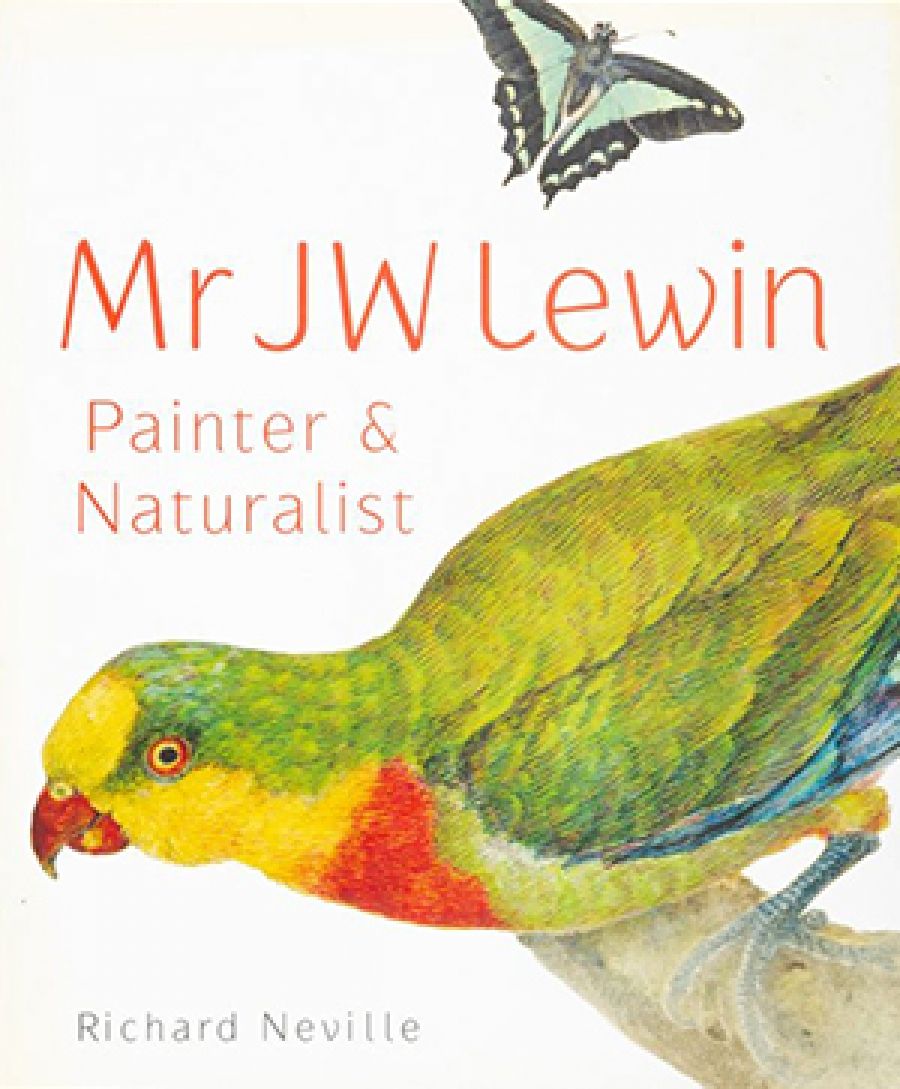
- Free Article: No
- Contents Category: Art
- Review Article: Yes
- Online Only: No
- Custom Highlight Text:
Rich in achievement, the artist and naturalist John William Lewin died in Sydney on 27 August 1819; he was forty-nine. With public funds, a stone was erected over his grave in the city’s new cemetery in Devonshire Street. While the inscription referred to Lewin’s official status as the town coroner, its discursive text lamented the loss ‘to this country of an Eminent Artist in his line of Natural History Painting in which he excelled’. Two years previously, in an official dispatch commending several fine drawings to the secretary of colonies in London, Governor Lachlan Macquarie – the last but most significant of a succession of vice-regal admirers and patrons – had praised ‘the Masterly Hand of Mr Lewin’. Schooled in England in a tradition of generic natural history illustration in which specimens were placed at the centre of a page devoid of all context, in Australia Lewin’s work was transformed by precise observations and an innovative approach to the illustration of natural history that was unprecedented. For him, New South Wales – its landscape, flora, and fauna, its Indigenous inhabitants, its own growth to a settled colony – was literally inspiring.
- Book 1 Title: Mr JW Lewin
- Book 1 Subtitle: Painter & Naturalist
- Book 1 Biblio: NewSouth Publishing, $39.99 pb, 272 pp
Now, almost two hundred years since Lewin’s death, author Richard Neville’s own masterly hand has performed a significant miracle of biographical retrieval and interpretation that does honour to a life that has been only imperfectly known. Lewin’s achievements are singular: in 1800 he was the first professional artist to emigrate to New South Wales; he was the colony’s first printmaker; his paintings would decorate the walls of Government House; and in 1813 his small quarto volume The Birds of New South Wales with their Natural History was not only the first illustrated book published in Australia but also the first truly private publication issued in the country. While not a work of systematic classification or description, that book itself is a landmark and a fabled rarity: it survives in only thirteen recorded copies. Book historian Jonathan Wantrup has called it an outstanding artefact, its text printed with an elegant and classical simplicity that stands as the highest typographical achievement of George Howe, the colony’s pioneer printer. Visually, its special interest is in Lewin’s illustrations of the ecology of birds. Here they are not presented as lifeless specimens, but are drawn and painted in their natural environment with what Neville observes is ‘a startling confidence, boldness and literalness’.
Sadly, even now, the larger Lewin story is thin, though it is engagingly written, with an eye to anecdote and detail. However, this thinness – a personality is hard to discern – appears to be a deficiency of the record rather than of authorship. The thirty years of Lewin’s life in England before his journey to Australia remain, as they have been to other writers, almost entirely blank. There is nothing to match the bird man John Gould’s perhaps romantically coloured childhood recollection, hoisted on the arms of his father and gazing with wonder at a clutch of verditer-blue eggs in the nest of a hedgesparrow in the family’s English garden, and thus beginning a romance with nature and ‘her charming attributes’. Lewin’s quietly industrious story has been ‘reconstructed from slivers of information scattered across newspapers and archives and only occasionally illuminated by richer sources’. It is surprising perhaps that no visual portrait or self-portrait of the man survives.
 Telopea speciosissima, John Lewin (National Gallery of Australia)
Telopea speciosissima, John Lewin (National Gallery of Australia)
Neville, however, gives us more than we have had before. His is the first sustained, coherent, and engaging account that vividly places his subject within the social fabric of the young colony and that gives a sense of Lewin’s own ambitions and motivation as an artist. Importantly, the book offers a systematic and critical appraisal of the range of Lewin’s substantial artistic legacy while also documenting the connections between artists and scientific explorers and the beginnings of public patronage in the early years of cultural formation in Australia.
This generously illustrated account draws on the great depth of the Lewin holdings in the State Library of New South Wales and on a smaller number of distinguished works held in Canberra by the National Library of Australia (NLA); one treat is the wonderful Fish Catch and Dawes Point (c.1817), a celebration of Australia’s natural bounty, held in the Art Gallery of South Australia. This late and confident essay in oils is a testament to ambition and to Lewin’s enthusiasm for a medium he had come to around 1812 and which, in his own view of himself, marked his transition from illustrator to a fully fledged painter. Neville has known and loved Lewin’s work intimately for many years, first as a curator in the Library’s great pictures collection, and more recently as Mitchell Librarian. His enthusiasm for the work, and his discerning and critical eye, are apparent throughout. To coincide with the publication of this book, he has curated Lewin: Wild Art, the artist’s first full retrospective. Given the inherent fragility of the works, this is a rare opportunity. The exhibition has recently completed its showing in the Mitchell Galleries in Sydney and will be on view at the National Library until October this year.


Comments powered by CComment